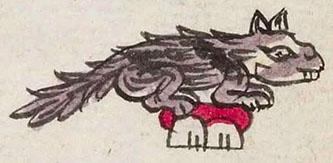Epatlan (Mdz42r)
This compound glyph for the place name Epatlan features a skunk (epatl) and a pair of front teeth (tlantli) that provides the phonetic "tlan" that is the locative suffix (meaning place of). The animal is shown in profile, facing to the viewer's right. It is crouching. Its coat is primarily gray-purple. Two black stripes run at an angle across the back, and the coat is rather spiky along the back and tail. The tail is long and full. The animal's front teeth are showing (in addition to the two front, white, human teeth with red gums below the animal). The animal's face has a small amount of white.
Stephanie Wood
The gloss does show a final "n" on the locative suffix, so there is no indication of abundance in the language used (which -tla or -tlah would have indicated).
Stephanie Wood
epatlan. puo
Epatlan, pueblo
Stephanie Wood
c. 1541, but by 1553 at the latest
Stephanie Wood
skunks, zorrillos, teeth, dientes, nombres de lugares

epa(tl), skunk, https://nahuatl.wired-humanities.org/content/epatl
-tlan (locative suffix), place, https://nahuatl.wired-humanities.org/content/tlan
"Skunk Place" [Frances Karttunen, unpublished manuscript, used here with her permission.]
"Where There Are Many Skunks" (Berdan and Anawalt, 1992, vol. 1, p. 187)
"El Lugar del Zorrillo"
Stephanie Wood
Codex Mendoza, folio 42 recto, https://digital.bodleian.ox.ac.uk/objects/2fea788e-2aa2-4f08-b6d9-648c00..., image 94 of 188.
The Bodleian Libraries, University of Oxford, hold the original manuscript, the MS. Arch. Selden. A. 1. This image is published here under the UK Creative Commons, “Attribution-NonCommercial-ShareAlike 3.0 License” (CC-BY-NC-SA 3.0).



